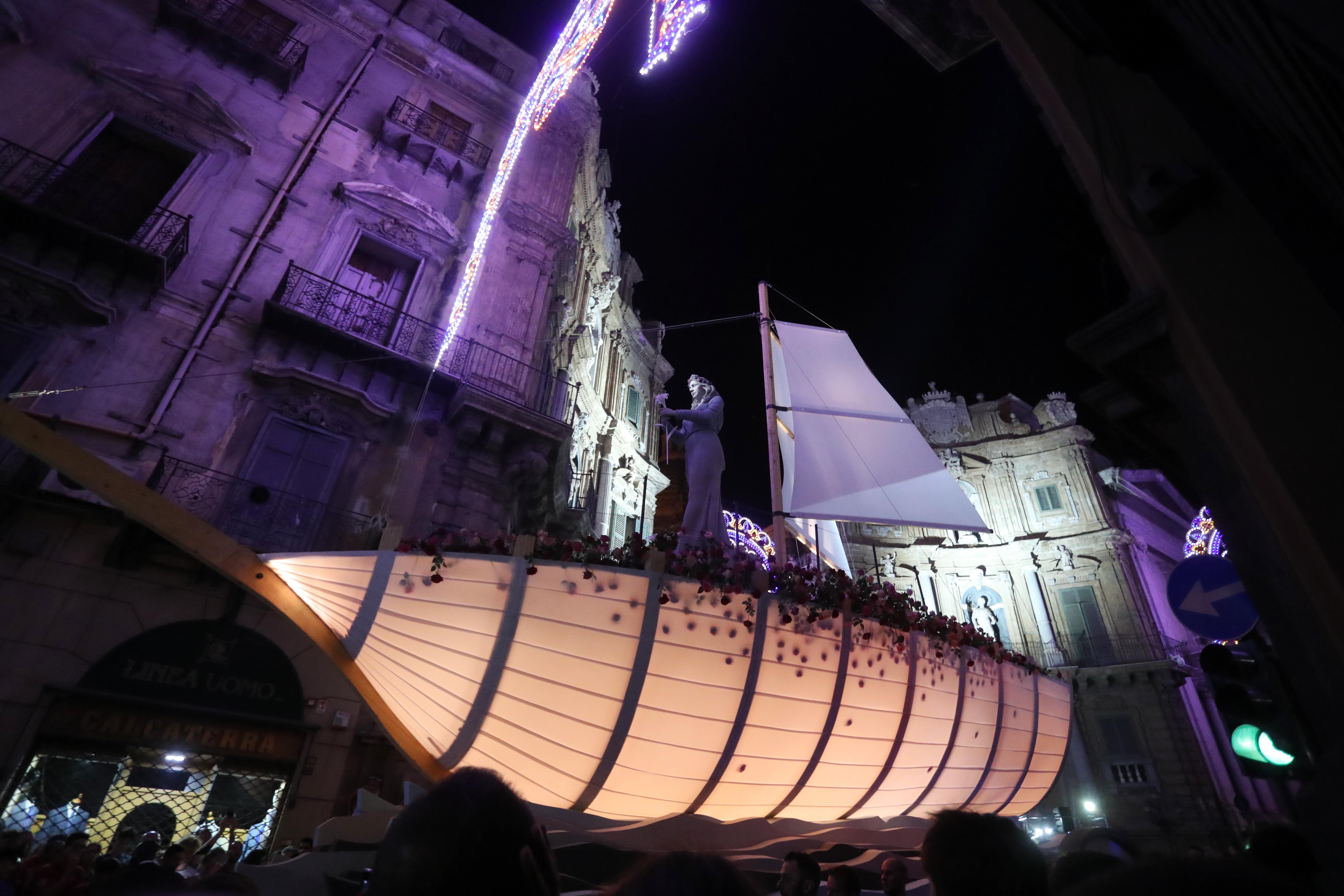
History of the Fistinu
A centuries-old tradition that began way back in 1625
It is said that the viceroy Caracciolo had tried to cancel the Fistinu with an ordinance, but he quickly had to backtrack, after he was "advised" to leave the celebration alone.
You can take anything away from the people of Palermo, but not their Santuzza!
The viceroy had to give in, and the famous procession that had crossed Palermo since 1624 was also held in that long ago year of 1783.
Here it is, the Festino, and here is the carro trionfale (triumphal float), a truly elaborate piece of stage machinery signalling power and hope, but also thanksgiving and faith, all combined in that little blonde saint who saved the city from the plague, succeeding in an undertaking that the four co-patronesses looking out from the Quattro Canti - Santa Cristina, Santa Ninfa, Sant'Oliva and Sant'Agata - had failed to complete: stopping the epidemic.
The relics of Santa Rosalia, on the other hand, which had been found on Montepellegrino, were carried in procession and the plague disappeared just as quickly as it had arrived. "As they passed, the disease eased, became less intense, lost its gravity - writes Giuseppe Pitrè in his "The Popular Festivals of Santa Rosalia in Palermo (1885)" - Palermo was soon free, and in recognition of so much benefit became devoted to you".
Since then, Palermo has celebrated Santuzza with a seven-day feast; and again on September 4, the day of Rosalia's birth, with the famous "acchianata" on the mountain.
But let us go back to the Festino: the true carro trionfale was born in 1686, while until then four small floats had alternated in procession. The sculpture was created earlier, in 1625, by Gregorio Tedeschi, made of marble, gold and precious stones; the relics are kept in a silver urn, made in 1631 by craftsmen Francesco Ruvolo, Gian Nicola Viviano and Matteo Lo Castro.
The float, which was rebuilt every year, was so large and heavy – with the famous muntagnedda d'oru – that it had to be pulled by at least 40 richly harnessed mules (later replaced by 50 oxen), and preceded by smaller floats, the macchinette, representing the various neighbourhoods of Palermo.
In 1701 the architect Paolo Amato designed an imposing float measuring at least 10 meters long, in the shape of a ship, a true mobile stage (the idea would be taken up again in 1974 by Greek architect Rodo Santoro, and revived again in 2003) populated with scenes from the life of the saint, whose statue was placed at the top, “Rosalia of the snow-white robes, with her head crowned with roses, her face radiant with beauty, who towered over the tallest buildings on the Corso; and she had a myriad of angels supported by clouds around her, at her feet”. (Pitrè)
"La beneficiata" took place in Piazza Marina, a lottery during which silver coins were glued onto the precious prizes that were drawn, drapery and paintings on wood. From the second to the fourth day of the Festino, the race of the Cursi, the Berber horses, was held on the Cassaro, and foundlings became jockeys for a day.
When it was decided after a few years that the animals would race without riders, balls and goads were attached to the horses' manes and tails to excite them to run faster.
The Festino went on throughout the eighteenth century, the carro becoming ever more spectacular: it was not held in 1837 due to the cholera epidemic, and was stopped again from 1848 to 1849, during the anti-Bourbon revolution.
A carro in the shape of a large tub decorated with cherubs was designed for the unification of Italy; in 1896, inspired by Pitrè himself, the cart was so large that it could not pass through the narrow streets of the centre, and had to proceed outside the city gates.
A scenic revival was attempted in 1924 (to celebrate the three hundredth anniversary of the discovery of the saint's bones), when a stationary machine was built with a central tower 25 meters high. But the wars came and with them a new pause: not until 1974 did the float return to the city, and the triumphal Festino was not held again until the early 2000s.
The most famous carro include one by Jannis Kounellis with a sail of Swarovski crystals (2007); a ship-float covered with gold leaf (2009); a Baroque rose garden (2010 and 2011); a theatrical project by Renzo Milan (2012), and a chequered design by Sergio Pausig (2015).













